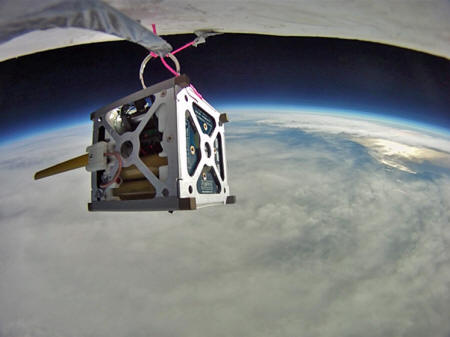|
The space race to launch satellites providing internet coverage to the roughly 4 billion people living in unconnected or nominally connected communities around the world is no longer just the purview of billionaire moguls and the world's biggest Internet companies.
Outernet, a small, independently-funded media company with a unique vision for distributing Internet content like a radio broadcast, is partnering with the UK Space Agency, and Scottish satellite equipment manufacturer, Clyde Space, on a cost-sharing project for manufacturing "cubesats."
The information broadcaster Outernet will launch their three new nano-satellites at the beginning of 2016, says Outernet's chief operating officer, Thane Richard.
Through the arrangement, Outernet gets the satellites, and the UK Space Agency and Clyde Space get an opportunity to develop more cost-effective ways of building cubesats.
The company currently leases bandwidth over the KU band to distribute its curated content.
With the launch of the satellites next year, the company will be able to broadcast on different frequencies from cubesats in low earth orbits.
That means lower costs for Outernet's target markets, which are already at the bottom of the economic food chain, since Outernet can use more commodity parts to make its receivers.
Outernet is the modern version of shortwave radio. As the world moves towards a global knowledge-driven economy, more than 3 billion people are excluded by cost, geography or jurisdiction.
Launched in late January 2014 as the first project incubated by the Media Development Investment Fund (MDIF), Outernet envisions a different kind of access to information than the ubiquitous internet connectivity Facebook and Google are working towards with Internet.org and Project Loon.
The company has financed its growth primarily through the MDIF and an Indiegogo campaign, which has raised over $500,000, basically as sales for the company's first product - a receiver called 'the Lantern.'
Named for its goal to shine the light of knowledge in the dark, unconnected parts of the world, the Lantern is a $169 device that continuously receives radio waves broadcast from Outernet's leased network of satellites.
The receiver converts those signals into digital files, and broadcasts can range from websites, to ebooks, to articles, videos and music.
Those digital files are then stored on Lantern's internal drive and can be accessed with any WiFi enabled device that connects to the gadget's Wi-Fi hotspot.
Outernet's content is curated and filtered by a series of editors, but anyone, anywhere in the world can request that certain information be distributed by the service.
So far, the company has been broadcasting in North America and Europe, the Middle East, and Northern and Sub-Saharan Africa, with the North American and EMEA stream going live in August 2014, while Sub-Saharan Africa began receiving content in December.
Asian content distribution will happen within the next three months, according to Richard.
The Loon, The Net, and The Next Wave Radio
Outernet isn't the first company tackling connectivity to find a willing partner in Europe.
For all of its privacy woes on the continent, Google managed to snag the Centre National d'Etudes Spatiales (CNES), as a collaborator on its Project Loon.
CNES has long been involved in upper-atmospheric balloon launches, and was encouraged by the progress that Google had shown in its initial deployments in rural New Zealand.
Indeed, Google's Loon project is now almost ready for prime time.
The company's vision to connect everyone to the Internet using an armada of upper atmospheric balloons harnessed with routers that can provide internet coverage for an area the size of Rhode Island is set to be a really big business.
Whether it's hubris or prescience, executives within the company say that the Loon project could be worth billions.
Here's what project leader Mike Cassidy told The Verge's Ben Popper:
The strides that Google is making with Loon to pull away from the connectivity pack are being matched by Facebook's own efforts around Internet.org.
In Barcelona last week for the Mobile World Congress trade show, Mark Zuckerberg spoke of his own vision for connectivity.
Unlike the Loon hardware, which is focused on connectivity, Zuckerberg and Facebook are emphasizing the roles that carriers have to play in promoting and increasing access.
As our own Josh Constine wrote about Zuckerberg's talk:
What he meant was that the barriers to access are really the cost of data plans and lack of education about why the Internet is important.
Zuckerberg said it's Internet.org's mobile operator partners that are making the real investments and bets on behalf of access.
So if Google has a vision of floating clusters of connectivity, and Facebook is working with carriers to drive down costs and offer no-cost data for selected curated sites, what's left for Outernet?
Given its roots as a media company first, Outernet is concerned with the distribution and access to content, rather than connectivity (although that's part of the company's plans as well).
The service is more akin to the next wave of radio, rather than the interactivity of an online browsing experience, except it distributes much more than just sound.
In some instances, Richard says, that passivity can be a virtue. In countries where access to certain information is restricted and authoritarian regimes dominate, having a service that provides access to useful information but doesn't track who is accessing the information, what information they're consuming, and where they're consuming it can be a virtue.
But Is The Content Any Good?
Because the service is a hodgepodge of information that's been selected from the requests of users, and curated by the company itself, Outernet's service can be transmitting data running the gamut from malarkey to must-read, depending on who's doing the voting.
That and the fact that right now the lingua franca for much of what Outernet distributes is English, means that there's only so much impact the data can have in a developing economy, where not everyone is fluent.
|

